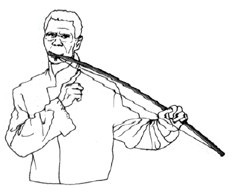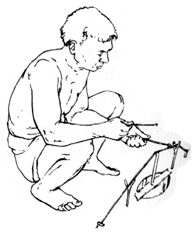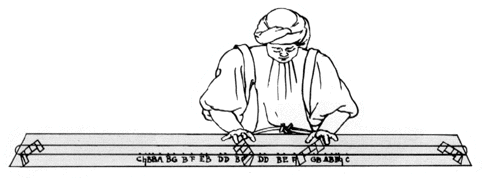|
The monochord (from the Greek "one string") was developed by Pythagoras to measure the intervals of a scale. It had one string, a resonance body with two fixed and two flexible frets. A modern monochord is made of a resonance box with many strings. All of them have the same length and thickness and are tuned to the same note. By stroking them with hands, a bow or.... a variety of natural overtones arise. By segmenting the strings with frets, one can tune them to a scale.
Today the monochord is used mainly in music therapy, harmonic research, sound meditation and free musical styles.
The first time I experienced the monochord was during a singing lesson. After several vocal exercises we had a small break and my teacher suggested an experiment. In a class for instrument making he had built himself a monochord. He invited me to lie down, to relax and to encounter the sound. I do not remember how long the experience took. I only know that afterwards my singing sounded completely different. The sound was much richer and it felt so good. At this time I had already completed my training as a cabinet-maker. With much interest I started to examine this "box with many strings" and noticed that it was built in a very simple way. Thus I decided to build myself a monochord, too. And because two of my friends were very interested, too, I built three of them. This was the beginning of my instrument making.
There came many years where I built many "boxes". I experimented with sound boxes made from massive wood, with electrical and crank monochords, and also with posh, curved "Porsche" types with elegant suspensions etc...
Children's monochord - a dialogue
In this paragraph I would like to tell you the creation story of this instrument in connection with a recurring and important theme of my work: dialogue.
In spring 1990 a friend visited me in my workshop. She woks as an educator and came with her seven months old son Johannes. We wanted to talk in peace, therefore I put my old guitar on the ground for Johannes to play with. Slowly and with great pleasure he began to discover the instrument: he pulled it along, sat on it, played with the strings, filled chippings into the soundhole and.... We became more and more fascinated by his playing and started to wonder: "What kind of instrument does a child need?" At the same time we noticed that there are hardly any instruments which are fully adequate for children. Thus we began to develop ideas for a children's monochord: the resonance box could also be used to crawl through, the instrument should be solid and safe, it should invite children to play - not only in a musical sense - and provide a space for experiences.
The project rested for nearly a year until two music therapists wanted to buy a monochord for their work with children. I told them that in my opinion an ordinary monochord with a closed resonance box was not appropriate for children. I shared with them my project and told them about an old monochord made of solid wood which would be more adequate because of its solidity (i.e. a child could safely climb over it) and its well-balanced and even sound. Spontaneously I decided to build a sturdy quadrangular wooden tube, one surface of which should be used as a monochord. When we parted, we all were very excited.
Afterwards I went to a meditation retreat for one week. On my return I realised that I was still looking at the monochord from an adult's perspective. I decided to ask myself intuitively how children would like THEIR instrument to be. I imagined them crawling through the tube, and after a while the tube started to swing. The idea was born to make the children's monochord into a swing as well.
Sound Boat - "watering the inner being"
Now my friends and I started with great fascination to squeeze ourselves, head-first, into the tube, and to begin to swing. But after a while we noticed that the tube was too narrow and that the sound was too strong for some of us. Therefore the instrument was modified into a Sound Boat.
The sound is created by 40 brass strings on the bottom side, tuned to one note. Side-planks, a silk-cloth suspended like a canopy, the swinging movement, the attitude of the player - all these components support the person lying in the boat. He or she feels sheltered and carried, and the player develops the feeling: "I am here for you only." During summer 1994 I participated in a family retreat at Plum Village, the meditation center of Thich Nhat Hanh in France. Inspired by the caring and mindful atmosphere in this community I titled my work with the Sound Boat "watering the inner being". When riding the Sound Boat together we turn to our inner being which exists in everybody. Most of the time, however, we do not care for it, but it is only waiting to be watered. In another metaphor we could imagine that each of us, man or woman, carries a baby inside, a baby of awakening, understanding and love. We should care for it in the same way a pregnant mother cares for her unborn child. Playing with the Sound Boat is a symbol for this, a possibility to live and share a common experience. At first we may think: "we cannot do it, we have too many other problems, there are other things we have to do today..." Here I want to invite you to use your own imagination and experiences to understand this text.
Sound Swing - "a friend for all occasions"
In the following I want to describe an experience with a child. It will illustrate what I mean with "a friend for all occasions".
One day I was in a large institution for handicapped children. I wanted to give them and their nurses the opportunity to experience the Sound Swing. There was a 5-year-old boy called Jens who was hyperactive and hard of hearing. His nurse had already experienced the Sound Swing in the morning and got the feeling that Jens would benefit from lying in the "womb" of the instrument and from listening. But he did not seem to like the idea and started to inspect the holes of the Sound Swing and to run around it. No sign of him calming down. Now we were inspired to throw marbles into the holes at the sides in order to animate Jens to climb into the instrument and to collect them again. But he wanted to participate in what we did, and he especially enjoyed the sound becoming louder and louder. After a while he found the procedure too slow and he emptied the whole bowl of marbles at once into one of the big holes. Then he started to swing the instrument and got totally carried away. The movements became bigger, the sound became louder, the marbles flew wildly back and forth... and suddenly they all soared out of the instrument and onto the carpet. Jens stood quiet. He had achieved a point of total silence.
In this situation the Sound Swing had been a friend for the boy, offering itself for the wild play with the marbles and for the large movements.
On this day Jens had come to trust his friend. Perhaps another day he will lie down in the shelter of the instrument and find peace in its gently swinging. But the friend will be just the same, a friend for all occasions.
Sound Friend - "to touch and to be touched"
"In the realm of the senses "touch" is always mutual. We can observe without being observed, we can hear without being heard etc, but we cannot touch something without being touched, too" (Steindl Rast 1994).
I often experience this feeling of being touched, especially when I meet handicapped people and children The tense hand of a disabled child begins to relax when playing the strings, the child's body longs for close contact with the instrument. When the strings are touched the instrument answers with sounds, echoing for a long time.
The Sound Friend makes such touching experiences possible. It is sturdy and handy. The strings are close to each other, yet on both sides of the board there is enough space for the fingers to start and finish their sliding movements. And due to its shape it motivates all kinds of games.
Finally I want to thank everyone who supported my work: instrument makers, visual artists, movement therapists and all who, by being open for the instruments and the people, enrich both the dialogue and my work. My special gratitude goes to the children and handicapped people who are my teachers time and again: when they search sounds in a room, when they show me how to find the most intimate contact with an instrument, when they eagerly play an instrument and discover it anew in each movement.
This article was published in 1995 in a German magazine.
P.S.: My experience has shown that all my instruments are versatile, despite having been built for a specific group of people. The Sound Friend - which was developed for multi-handicapped people- is at home with children and adults, old and young, the sick and the healthy. The Sound Swing - build for children and adolescents in psychiatric care - also unfolds its various possibilities for handicapped people and adults. "Which instrument for which environment?" is an important question I am asked repeatedly.
I am happy to send you information about details, prices, courses and new projects. Suggestions and questions are very welcome.
With kind regards
|




